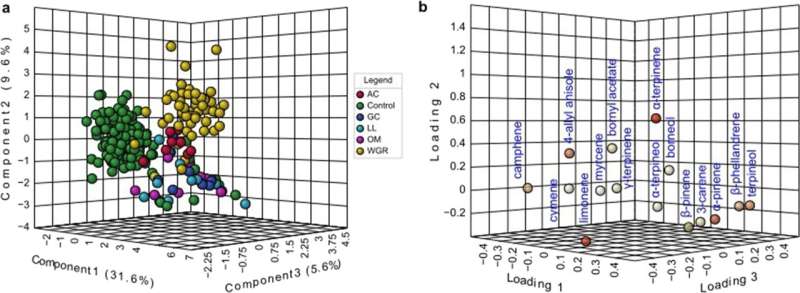This article has been reviewed according to Science X's editorial process and policies. Editors have highlighted the following attributes while ensuring the content's credibility:
fact-checked
trusted source
proofread
Fungal infections affect pine trees' ability to ward off mountain pine beetles

University of Alberta research provides new insight into how harmful fungal infections could affect the ability of lodgepole pines to defend themselves from deadly mountain pine beetle attacks.
Using five different pathogens, the study revealed that the fungal infections had varied effects on the trees' defense chemistry, suggesting that they could either be more resilient or more susceptible to subsequent attacks by the insect.
The findings, published in the journal Microbial Ecology, could lead to new ways to protect mature lodgepole pine trees—important to forest ecology and the forest industry—from disease and insect infestation, says Rashaduz Zaman, who led the study and is working towards a Ph.D. in forest biology and management from the Faculty of Agricultural, Life & Environmental Sciences.
One of the most widespread coniferous trees in western North America, lodgepole pines make up about 35% of the forested land in Alberta and British Columbia and are becoming more vulnerable to pests as global temperatures grow warmer, he notes.
"There is an increasing need to expand the tools to keep mountain pine beetle under control, and knowing more about the tree's defense chemistry will help with this."
For the experiment, the researchers took samples of phloem tissues—the tree's vascular tissue in charge of transporting and distributing nutrients—from lodgepole pines infected with Atropellis canker and western gall rust, two of the most common fungal diseases affecting the trees in Western Canada.
They also infected mature lodgepole pines with three symbiotic fungal pathogens associated with the mountain pine beetle and collected phloem samples from those trees two weeks later, when the defense chemistry was at its highest level.
The chemical profiles of these samples were then compared with those from healthy trees.
Overall, the results showed that the three symbiotic fungal species and the western gall rust altered terpenes—metabolites in the pine tree that help launch a chemical defense against infection—similarly, by reducing the production of compounds toxic to mountain pine beetles, suggesting these trees could be vulnerable to infestation.
However, the pathogen causing the canker had a different effect: it was the only one that increased the production of most of the terpenes that are toxic to the beetle. In addition, the study identified, for the first time, 66 metabolites exclusively associated with the canker, which can indicate how severe the infection is and also differentiate the disease from western gall rust.
The findings show the value of using the emerging approach of metabolomics—the tree's own chemistry—as a diagnostic tool, says Zaman, who works under the supervision of U of A forest entomologist Nadir Erbilgin, one of the co-authors on the study.
"The process helps us understand how infection alters the host tree's defense chemistry, making it vulnerable to mountain pine beetle attack. This gives us information long before an attack."
Much earlier diagnosis is crucial to ultimately lessening the trees' susceptibility to pest invasion, he adds.
"If we can detect the trees in the early stages of infection in a forest, management practices can prevent the spread of the infection by measures such as using insect traps and harvesting healthy trees to avoid spread, or by burning infected trees."
As well, the researchers developed a potential monitoring tool through the study, by baiting insect traps with the chemical compounds taken from trees infected by each of the five fungal pathogens. Hung in the forest, the traps—which Zaman hopes can eventually be used by forest managers on a widespread basis—showed which of the terpenes attracted or repelled mountain pine beetles.
They were also useful in detecting the low density of the mountain pine beetles, which is important to forest ecology, says Zaman.
Currently, available baits only attract the beetles when their population is high, so a product is needed to monitor the insects when their numbers are low and beneficial to forest health.
"By attacking weak and dead trees, the beetle helps with decomposition, so we don't want to eradicate it as a species."
The findings also represent a stepping stone for further research aimed at breeding the trees to be more resistant to disease-causing fungi and pests like mountain pine beetles, says Zaman.
"We've been able to show which metabolic compounds are responsible for a specific pathogen. With more research, we can understand which specific genes are responsible for the production of toxic compounds, and then we can create more resistant genotypes of the tree."
More information: Rashaduz Zaman et al, A Pine in Distress: How Infection by Different Pathogenic Fungi Affect Lodgepole Pine Chemical Defenses, Microbial Ecology (2023). DOI: 10.1007/s00248-023-02272-0
Provided by University of Alberta


















